Rainman Watermakers unveiled two new watermaker models on January 16, 2019. I was honored to be part of the event — and extremely curious to see them.
I had loved the portable Rainman system we were allowed to use for six weeks last summer for review purposes (read my final review) but it was just a little too large for us to install where we’d like in Barefoot Gal. The new systems were promised as being smaller but with the same output, with one still being a portable unit and the other designed for installation.
Rainman Systems in General
Older watermakers, such as Pur, Village Marine, Katadyn and Spectra were designed to be two things: (1) extremely energy efficient and (2) as self-tending as possible.
Energy Efficiency
Just ten years ago, large solar arrays and/or generators were not that common on cruising boats. Battery charging was not nearly as efficient and battery banks were, on average, smaller. Consequently, every electrical system on a boat had to be designed for the least power required. And the older watermakers were no exception.
To make them as energy efficient as possible, engineers designed proprietary pumps, membranes and electronic controls. Initially, they worked well. Spectra was perhaps the most energy efficient of all, advertising that their systems used just one 12-volt amp-hour per gallon of water made.
Self-Tending
At the same time, people wanted systems that they didn’t have to pay much attention to. That would be more or less self-tending. More electronics were added to automatically raise the pump pressure to make water and to flush the membrane with fresh water as needed.
The Problems
Unfortunately, over time these systems had six problems:
- Proprietary parts were expensive to replace
- Proprietary parts had to be ordered from the manufacturer when needed and this wasn’t always convenient (or possible) if cruising outside the manufacturer’s home country
- Systems were not designed to be repaired in the field by owners
- Systems were complex, with many parts that could fail
- Low output — typically 3 to 8 gallons per hour — meant that most watermakers had to be run daily, tying cruisers to their boats for 1 to 2 or more hours and they’d still have to conserve water considerably
- Systems were noisy while running.
Rainman’s Solution
Rainman, and some other watermaker
- HIgher
outp ut - Fewer breakdowns
- Lower cost over the life of the watermaker
- Parts that could be found in most cities with over 100,000 people
- Systems designed to be repaired by owners, with lots of technical support from the manufacturer
- Higher capacity systems so they didn’t have to run nearly so many hours and could provide a better quality of life with more water for cleaning and showering as well as drinking and food preparation.
- Quieter operation
And they were willing to be more active in turning knobs and taking care of routine maintenance as they realized that, as boat maintenance goes, it was pretty simple to turn a knob to bring the unit up to pressure and to run a bucket of water to freshwater flush or pickle the system.
In 2014, Rainman came out with their inaugural line of watermakers. Not only did they meet the above requirements, but they were also portable. Easily moved from boat to boat so you could take yours with you if you changed boats. The most popular model would run on a Honda 2000 generator and made 30 to 37 gallons per hour.
Rainman’s Next Generation
Rainman introduced their next generation of watermakers to the world here in Marathon, Florida (US) two weeks ago and I’m blown away by how they’ve stayed true to their original vision while improving their product.
As with their previous watermakers, each unit is comprised of a pressure supply unit and a membrane assembly. There are three pressure supply units: 110/220 volt AC, 12 volt DC or gas-powered portable units; the AC and DC units also come in a “naked” configuration, designed to be installed. The gas-powered unit is unchanged; the 12-volt DC and the AC units (both portable and naked) are the new models. These can be paired with various membrane assemblies (different sizes and prices) to produce anywhere from 7 to 37 gallons per hour.
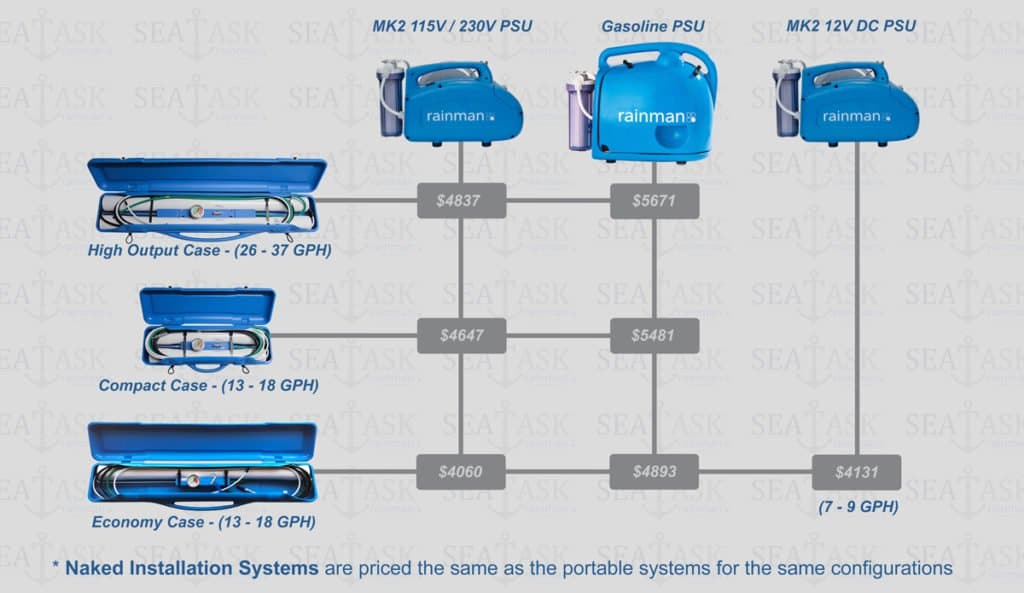
Size and Weight Savings
The
Other weight and space savings occurred by redesigning how some parts attach to each other, basically mating pieces to one another instead of having connecting pieces. Fewer parts
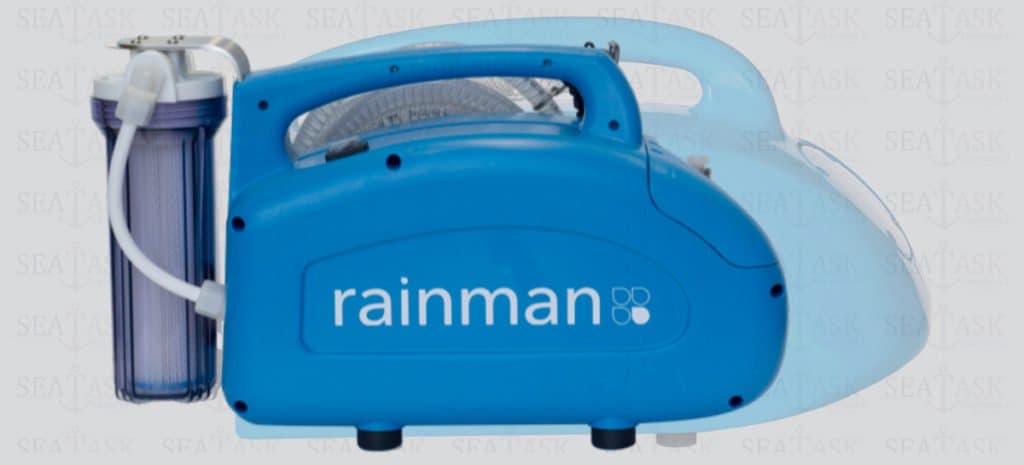
More important is the size difference. The portable unit is 30% smaller than the previous one, being both shorter in length and narrower. An added bonus is that the hose basket on the side of the unit is now removable. Many owners semi-install the portable units and don’t need to store the hoses right on the side of the unit. Removing the basket makes the unit about two inches narrower.
Overall, the new pressure supply unit weighs 9 pounds less than its predecessor. The portable AC unit has gone from 63 pounds to 54. While setting up for the show, I had to move both the old and new units one after the other, lifting them from the floor to a table. Believe me, the difference is noticeable and would be even more so if I was getting the unit out of a lazarette or sail locker.
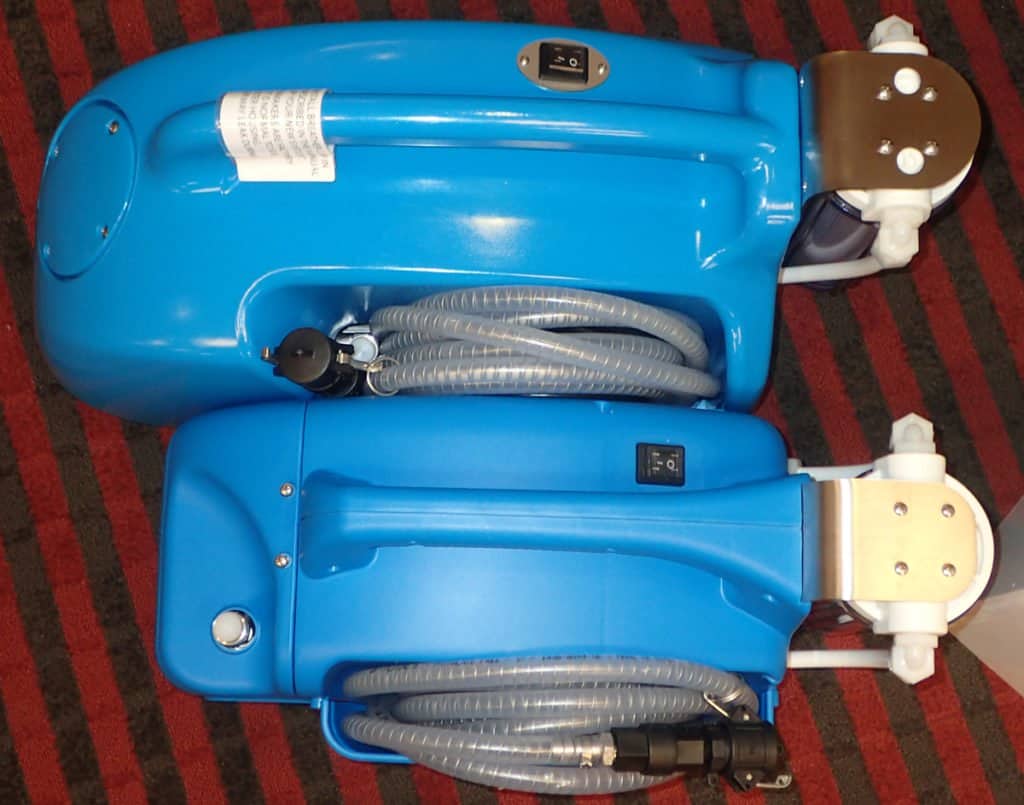
Comparison of the old (left) and new (right) Rainman AC units.
Repairs and Maintenance
At the same time, the reconfiguration gives total access to the unit’s internal parts, making owner repairs even easier. The engine oil sight is easier to check and the entire housing is much more easily removed.
All parts are still off the shelf, including the membranes. Both of our previous watermakers have used all proprietary parts and the costs really mount up over the life of a watermaker, especially if you have to pay shipping to get something to an out-of-the-way foreign location.
I don’t want it to sound like repairs are frequent on the Rainman units. But anyone living on a boat knows that any systems can need repair. Availability and cost of parts are critical considerations when purchasing anything, as are robust systems designed to have fewer potential failure points.
Other Improvements
Rainman incorporated two other significant improvements into the 2019 models. First is improved vibration dampening, meaning that it runs quieter than ever. Several people in attendance at the launch party commented on how it was by far the quietest watermaker they’d ever heard running. Yes, you’re probably going to be running a generator at the same time as you’re running the watermaker but even a quiet Honda 2000i is going to be louder than the Rainman.
After the launch party, we were taking additional pictures with the unit running. And as it happened, I received a phone call. I had no problem whatsoever talking on the phone while standing only a couple feet from the watermaker. I certainly couldn’t do that with the Katadyn 80E that came with Barefoot Gal!
The second improvement is a non-slip handle on the portable models. Along with the lighter weight, this makes it easier to pick up and move around without fear of dropping — always a concern on a moving boat.
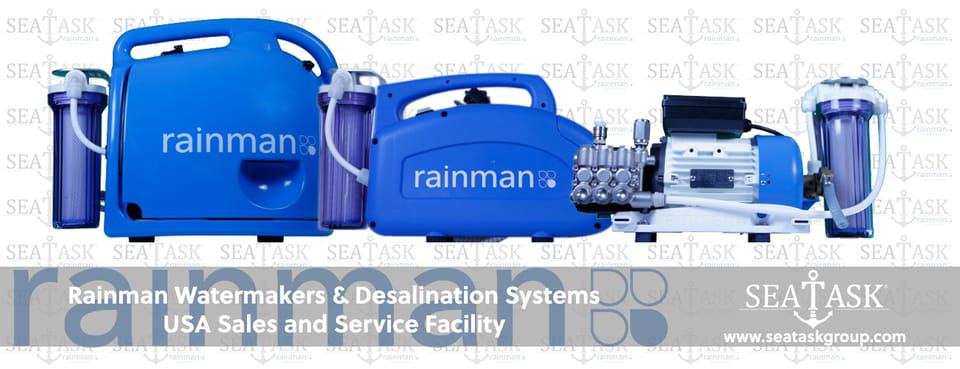
No Installation; No Thru-Hull Needed
The portable Rainman units need absolutely NO installation. Within 10 minutes of bringing the borrowed unit to the boat last summer, we were making water. And this is one of the main attractions of the units: no need to haul out and install a thru-hull. Getting a watermaker won’t interrupt your cruising plans.
Additionally, it cuts down considerably on the cost of a watermaker. Most other brands require a haul out unless you already have a thru-hull that can be used, and are intended to be professionally installed. Not needing a haul out or professional installation typically saves $1,000 to $2,000.
Finally, as the case can easily be removed from the portable unit, it’s possible to fully install it at a later date if you decide you want to. Or you can leave it in the case but attach it to a thru-hull if you decide that’s what you want (having a thru-hull makes it easier to use the watermaker underway).
Rainman Naked
It’s always been possible to install a Rainman unit. You could either mount the pressure supply unit right in the case, or you could remove it from the case. And ditto for the membranes, with the pressure controls being able to be mounted remotely.
Still, there was always the perception that Rainman was only a portable system. And there was also the problem that the old unit was just a little large for some boats — such as ours.
The Rainman Naked was designed to tackle both problems. The components are identical to the AC and DC portable units but are easily installed. Each of the parts — prefilter, pump unit, membranes and control valve/gauge — can be separately installed. All you need is a thru-hull to supply the salt water. Suddenly, a Rainman will fit where our old watermaker (which is on its last legs) did.
The systems are designed to be owner-installed, again offering a cost savings over those designed for professional installation. They can be hard-wired to the boat’s AC power system or generator, or you can use an extension cord. No DC wiring is needed. Mounting will vary by boat, but there are only four components: the prefilter, pump assembly, the membranes and the controls. Actually, it’s optional to remotely mount the controls but 99% of users will want to.
I was already sold on all the features of the Rainman system. I had so wanted the one we used last summer. Now, an improved model that will fit where we want to put it? Sign me up! Yes, we’re buying a new Rainman Naked unit with the high capacity membranes.
Unfortunately we couldn’t take it back to the boat from the launch party. Manufacture was just slightly delayed and we should have our unit by the end of February, possibly a little earlier. Right now, Rainman and its dealers are taking pre-orders for the new systems.
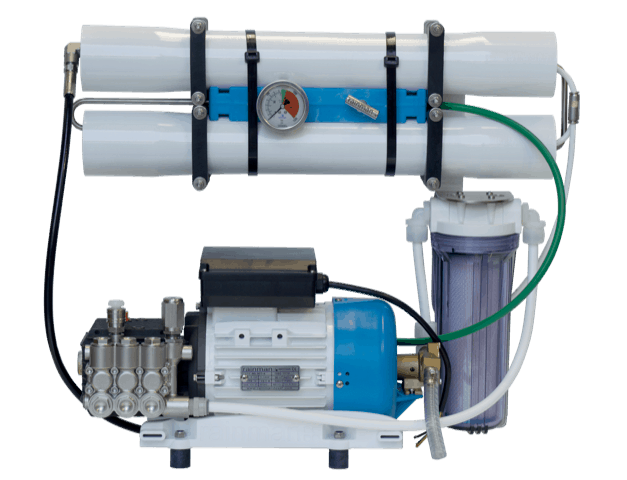
Pairing a Rainman with Lithium Batteries
So far, I’ve talked about using a Rainman AC unit with a generator. But guess what? It’s possible to run it from solar power if you have a sizable solar array, lithium batteries and a good 2000 watt inverter. After the launch party and demonstration, Alex Miller of Sea Tek (our local solar and lithium battery guru) brought by a 400 AH lithium bank with a Victron inverter/charger. We hooked up the Rainman unit and easily made 5 gallons of water. Neither the batteries nor the watermaker showed any sign of strain.
If you are thinking of a system like this, you might want to consult your marine electrical technician to make sure that you’ll have a sufficiently robust system: the size of the battery bank and solar install, the solar charger and the inverter. But know that it can work.
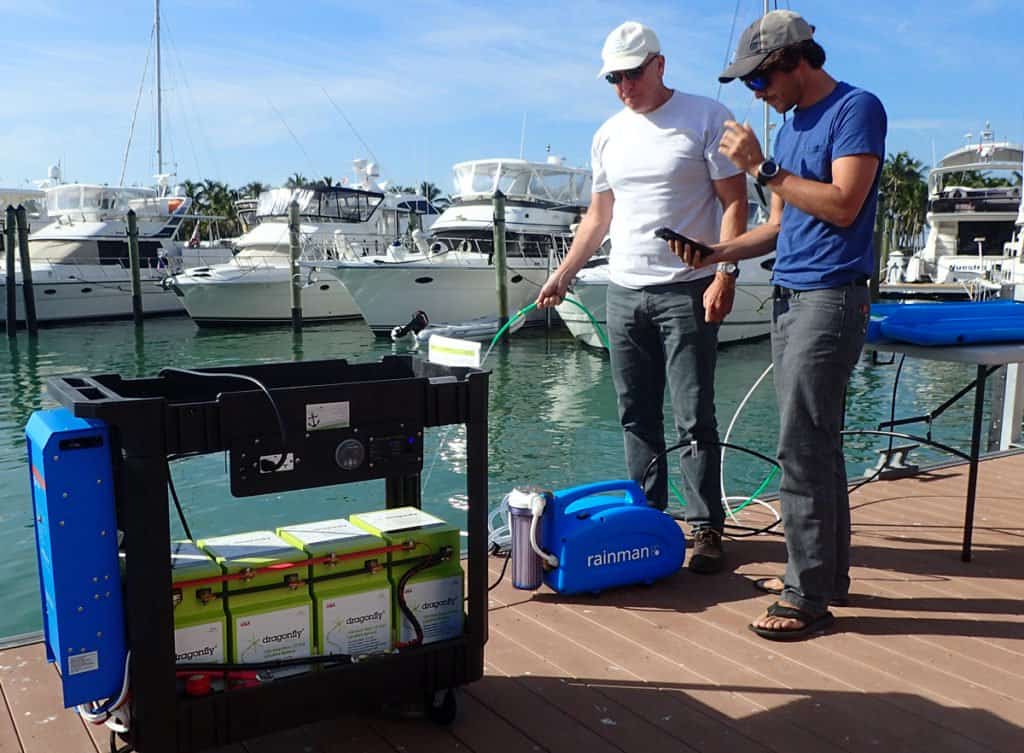
More Info
Additional helpful info:
- Detailed information on the units, including dimensions, here.
- Installation guidelines here
- Owners manual here
Got questions? Chris at SeaTask is more than happy to answer. Call him at 305 965 8775 (or text to that same number) or email him at [email protected].

Carolyn Shearlock has lived aboard full-time for 17 years, splitting her time between a Tayana 37 monohull and a Gemini 105 catamaran. She’s cruised over 14,000 miles, from Pacific Mexico and Central America to Florida and the Bahamas, gaining firsthand experience with the joys and challenges of life on the water.
Through The Boat Galley, Carolyn has helped thousands of people explore, prepare for, and enjoy life afloat. She shares her expertise as an instructor at Cruisers University, in leading boating publications, and through her bestselling book, The Boat Galley Cookbook. She is passionate about helping others embark on their liveaboard journey—making life on the water simpler, safer, and more enjoyable.
Here’s your “Quick Start” to everything you need to know when living on a boat:
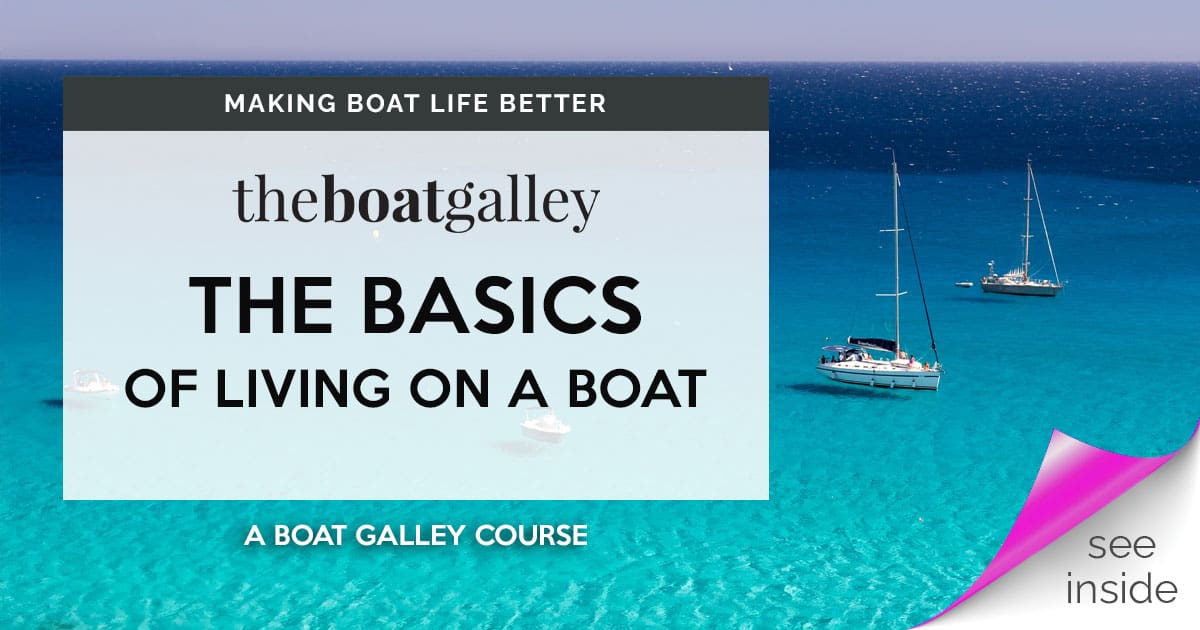

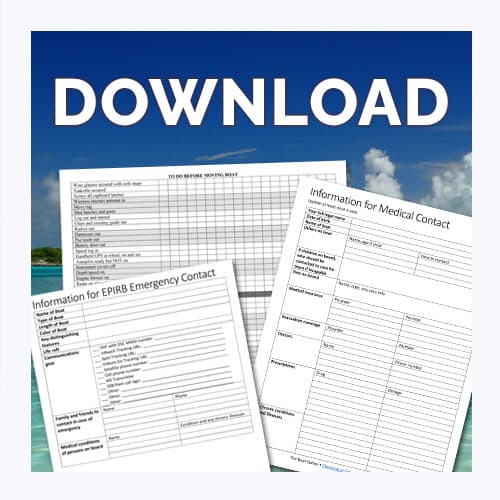





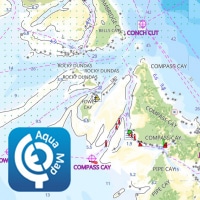
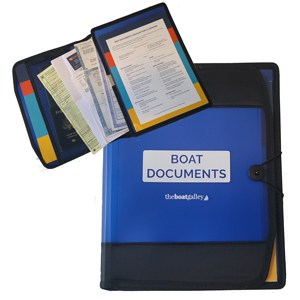

Tyler Heerwagen says
Nice report, great graphics. Thanks!
Tyler Heerwagen
Sea Wolf
Catalina 42
Alemeda CA
Bonnie Cavanaugh says
Great report… I’ve been shopping for a watermaker for over a year, think you e swayed me to a rainman…
47′ vegabound ketch sailboat, SV Content,
Currently in Hampton Virginia, going to sail around the world back to Seattle where all my family and friends are…